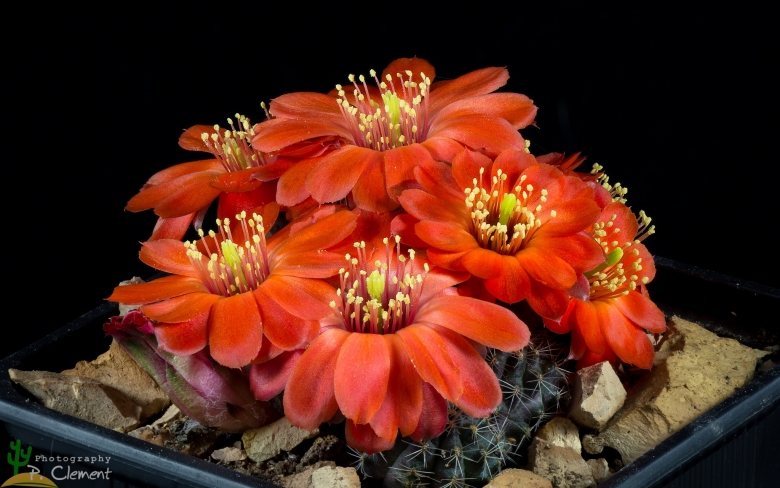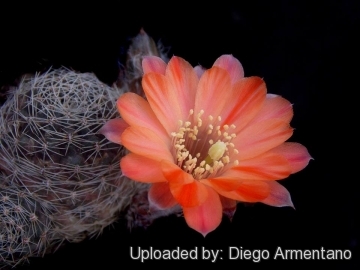Donate now to support the LLIFLE projects.
Your support is critical to our success.
Your support is critical to our success.
= Rebutia euanthema (Backeb.) Buining & Donald
Sukkulentenkunde vii-viii. 102(1963)
Accepted Scientific Name: Rebutia einsteinii subs. aureiflora (Backeb.) Hjertson
Cactaceae Syst. Init. 15: 10. 2003 [Apr 2003]

Mediolobivia euanthema (Rebutia euanthema) Photo by: Peiffer Clement
Umbrella made of flowers.
Umbrella made of flowers.
Synonyms:
- Rebutia euanthema (Backeb.) Buining & Donald
- Acantholobivia euanthema (Backeb.) Y.Itô
- Lobivia euanthema Backeb. in Backeb. & F.M.Knuth
- Mediolobivia euanthema (Backeb.) Krainz
See all synonyms of Rebutia einsteinii
back
Accepted name in llifle Database:Rebutia einsteinii Frič in Möller
Deutsche Gärtn.-Zeitung 1931, xlvi. 267, in obs.
Synonymy: 40
- Rebutia einsteinii Frič in Möller
- Aylostera einsteinii (Frič ex Kreuz. & Buining) Mosti & Papini
- Cylindrorebutia einsteinii Frič ex Kreuz. & Jucker
- Lobivia einsteinii (Frič) Rausch
- Mediolobivia schmiedcheniana var. einsteinii (Frič) Backeb.
- Rebulobivia einsteinii Frič
- Mediolobivia auranitida var. flaviflora Backeb.
- Rebutia auranitida (Wessner) Buining & Donald
- Cylindrorebutia auranitida (Wessner) Bredero
- Lobivia auranitida Wessner
- Mediolobivia auranitida (Wessner) Krainz
- Rebutia brighignae Mosti & Papini
- Aylostera brighignae (Mosti & Papini) Mosti & Papini
- Rebutia einsteinii f. columnaris (Wessner) Buining & Donald
- Cylindrorebutia columnaris (Wessner) Bredero
- Lobivia columnaris Wessner
- Mediolobivia columnaris (Wessner) Krainz
- Mediolobivia conoidea var. columnaris (Wessner) Backeb.
- Rebutia conoidea var. columnaris B.Fearn & Pearcy
- Rebutia einsteinii var. columnaris (Wessner) Buining & Donald
- Rebutia einsteinii var. conoidea (Wessner) Buining & Donald
- Lobivia conoidea Wessner
- Mediolobivia conoidea (Wessner) Krainz
- Rebutia einsteinii f. conoidea (Wessner) Donald
- Cylindrorebutia conoidea (Wessner) Bredero
- Rebutia einsteinii f. karreri (Backeb.) Buining & Donald
- Mediolobivia schmiedcheniana var. karreri Backeb.
- Rebutia karrerii Frič in Möller
- Rebutia einsteinii f. rubriviridis (Frič ex Backeb.) Donald
- Mediolobivia schmiedcheniana var. rubriviridis Frič ex Backeb.
- Rebutia einsteinii var. steineckei (Backeb.) Buining & Donald
- Rebutia euanthema f. neopygmaea (Backeb.) Buining & Donald
- Mediolobivia neopygmaea Backeb.
- Rebutia fischeriana Slaba
- Aylostera fischeriana (Slaba) Mosti & Papini
- Rebutia nicolaii Frič in Möller
- Cylindrorebutia nicolai Frič
- Mediolobivia einsteinii f. Nicolai hort. sensu Frič, Donald
- Rebulobivia nicolai Frič & Kreuz.
Rebutia einsteinii subs. aureiflora (Backeb.) Hjertson
Cactaceae Syst. Init. 15: 10. 2003 [Apr 2003]
Synonymy: 75
- Rebutia einsteinii subs. aureiflora (Backeb.) Hjertson
- Aylostera aureiflora (Backeb.) Mosti & Papini
- Lobivia aureiflora (Backeb.) H.P.Kelsey & Dayton
- Mediolobivia aureiflora (Backeb.) Backeb.
- Rebutia aureiflora Backeb.
- Mediolobivia aureiflora var. carminata (Backeb.) Backeb.
- Mediolobivia carminata Backeb. ex Krainz
- Mediolobivia aureiflora var. longiseta Backeb.
- Lobivia longiseta (Backeb.) H.P.Kelsey & Dayton
- Mediolobivia longiseta (Backeb.) Backeb.
- Mediolobivia aureiflora subvar. leucolutea Backeb.
- Mediolobivia aureiflora subvar. lilacinostoma Backeb.
- Mediolobivia rubriflora var. compactiflora (Wessner) Krainz
- Mediolobivia rubriflora var. nigrilongiseta (Wessner) Krainz
- Mediolobivia turbiniformis Backeb. ex Frič & Kreuz.
- Rebutia aureiflora var. albiseta (Backeb.) Borg
- Mediolobivia aureiflora var. albiseta Backeb.
- Setirebutia albiseta (Backeb.) Frič ex Kreuz.
- Rebutia aureiflora var. albi-longiseta (Backeb.) W.T.Marshall
- Mediolobivia aureiflora var. albi-longiseta Backeb.
- Mediolobivia longiseta var. albi-longiseta Backeb.
- Rebutia aureiflora var. blossfeldii (Werderm.) Donald
- Mediolobivia blossfeldii (Werderm.) Buining
- Mediolobivia rubriflora var. blossfeldii (Werderm.) Krainz
- Rebutia blossfeldii Werderm.
- Rebutia aureiflora f. boedekeriana (Backeb.) Šída
- Mediolobivia aureiflora var. boedekeriana (Backeb.) Backeb.
- Mediolobivia boedekeriana Backeb.
- Rebutia aureiflora f. duursmaiana (Backeb.) Šída
- Mediolobivia aureiflora var. duursmaiana (Backeb.) Backeb.
- Mediolobivia duursmaiana Backeb.
- Rebutia aureiflora var. elegans (Backeb.) Buining & Donald
- Mediolobivia elegans Backeb.
- Rebutia aureiflora subs. elegans (Backeb.) Donald
- Rebutia einsteinii var. elegans (Backeb.) Rausch
- Rebutia aureiflora f. kesselringiana (Cullmann) U.Köhler
- Mediolobivia kesselringiana Cullmann
- Rebutia aureiflora var. blossfeldii f. kesselringiana (Cullmann) Donald
- Rebutia aureiflora f. rubelliflora (Backeb.) Buining & Donald
- Mediolobivia aureiflora var. rubelliflora (Backeb.) Backeb.
- Mediolobivia rubelliflora Backeb.
- Rebutia aureiflora f. rubriflora (Backeb.) Buining & Donald
- Mediolobivia aureiflora var. rubriflora (Backeb.) Backeb.
- Mediolobivia rubriflora Backeb.
- Rebutia aureiflora f. sarothroides (Werderm.) Buining & Donald
- Mediolobivia aureiflora var. sarothroides (Werderm.) Backeb.
- Mediolobivia sarothroides (Werderm.) Buining
- Rebutia aureiflora var. sarothroides (Werderm.) Donald
- Rebutia sarothroides Werderm.
- Rebutia euanthema (Backeb.) Buining & Donald
- Acantholobivia euanthema (Backeb.) Y.Itô
- Lobivia euanthema Backeb. in Backeb. & F.M.Knuth
- Mediolobivia euanthema (Backeb.) Krainz
- Rebutia euanthema f. fricii (Backeb.) Buining & Donald
- Rebutia oculata Werderm.
- Aylostera oculata (Werderm.) Mosti & Papini
- Mediolobivia euanthema var. oculata (Werderm.) Krainz
- Rebutia euanthema f. oculata (Werderm.) Buining & Donald
- Rebutia oculata subs. tilcarensis (Rausch) Mosti
- Aylostera oculata subs. tilcarensis (Rausch) Mosti & Papini
- Lobivia euanthema var. tilcarensis Rausch
- Rebutia tilcarensis (Rausch) Šída
- Rebutia orurensis (Backeb.) F.Ritter
- Aylostera orurensis (Backeb.) Mosti & Papini
- Digitorebutia haagei var. orurensis (Backeb.) Donald
- Digitorebutia orurensis (Backeb.) Buining
- Lobivia orurensis Backeb. in Backeb. & F.M.Knuth
- Mediolobivia haagei var. orurensis (Backeb.) Donald
- Mediolobivia orurensis (Backeb.) Backeb.
- Mediolobivia pectinata var. orurensis (Backeb.) Backeb.
- Setirebutia disciformis Frič
Rebutia einsteinii subs. gonjianii (R.Kiesling) Hjertson
Cactaceae Syst. Init. 15: 10. 2003 [Apr 2003] nom. invalid.
Synonymy: 14
- Rebutia einsteinii subs. gonjianii (R.Kiesling) Hjertson
- Aylostera gonjianii (R.Kiesling) Mosti & Papini
- Cylindrorebutia gonjianii (Wahl)
- Digitorebutia einsteinii var. gonjianii
- Digitorebutia gonjianii (Wahl)
- Lobivia einsteinii var. gonjianii (R.Kiesling) Rausch
- Lobivia gonjianii (R.Kiesling) R.Kiesling
- Mediolobivia einsteinii var. gonjianii
- Mediolobivia gonjianii hort. sensu R.Kiesling
- Rebutia einsteinii var. gonjianii (R.Kiesling) Donald
- Rebutia gonjianii R.Kiesling
- Rebutia einsteinii subs. gonjianii f. cristata hort.
back

Rebutia euanthema. A rare variegated flower. (Rebutia euanthema) Photo by: Diego Armentano
Send a photo of this plant.
The gallery now contains thousands of pictures, however it is possible to do even more. We are, of course, seeking photos of species not yet shown in the gallery but not only that, we are also looking for better pictures than those already present. Read More...
The gallery now contains thousands of pictures, however it is possible to do even more. We are, of course, seeking photos of species not yet shown in the gallery but not only that, we are also looking for better pictures than those already present. Read More...
| Your Actions | |
|---|---|
| Back to Mediolobivia index | |
| Back to Cactaceae index | |
 |
Back to Cacti Encyclopedia index |








